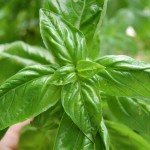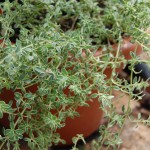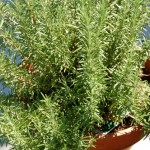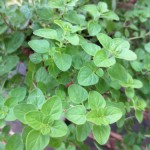Storing Herbs
Herbs are great: they are easy to grow, fairly easy to maintain, and produce way more than one person (or two) can use. That is, unless you store them for later – which is what you should do since you took the time and effort to grow them.
Different herbs require different storing processes in order to keep their taste fresh. Read on.
Basil
 Probably the most popular herb to grow at home, basil is also one of the easiest to store. Simply cut and freeze (either as whole leaves or chopped/puréed). Or dry. Or snip off the ends and place in a glass of water sitting on the counter. You really can’t go wrong.
Probably the most popular herb to grow at home, basil is also one of the easiest to store. Simply cut and freeze (either as whole leaves or chopped/puréed). Or dry. Or snip off the ends and place in a glass of water sitting on the counter. You really can’t go wrong.
Alternatively, if you have a lot of basil, consider turning it into pesto (my favourite method). Recipes are available online with a quick search and you can tailor your recipe to the type of basil you have available.
Thyme
 Keep thyme fresh in the fridge for up to two weeks by wrapping the leaves (still on the stems) in a damp paper towel and putting the whole lot into a sealable bag.
Keep thyme fresh in the fridge for up to two weeks by wrapping the leaves (still on the stems) in a damp paper towel and putting the whole lot into a sealable bag.
For longer storing (up to six months), freeze. You’ll want to wash, chop, and allow to dry before placing into sealable freezer bags. You can also dry (I recommend a dehydrator or a well ventilated area where they can be hung upside down). Once dry, crush and add to the spice rack.
Rosemary
 Rosemary is best stored by drying first. Like the thyme, gather several sprigs into bunches and tie at the bottom. Place paper bags around the leafy part of the plant and tie around the stems (to keep off dust, mostly). Cut slits into the bag for air flow and hang entire thing in a warm, dry plant.
Rosemary is best stored by drying first. Like the thyme, gather several sprigs into bunches and tie at the bottom. Place paper bags around the leafy part of the plant and tie around the stems (to keep off dust, mostly). Cut slits into the bag for air flow and hang entire thing in a warm, dry plant.
Dry plants can be removed from the bag. Crush the leaves and put into the spice rack.
Parsley
 Like basil, parsley can be kept in fresh water. But, instead of leaving on the counter, put it into the fridge. Keeps well for about two weeks.
Like basil, parsley can be kept in fresh water. But, instead of leaving on the counter, put it into the fridge. Keeps well for about two weeks.
To freeze parsley, your best bet is to wash and chop parsley into smaller pieces (not incredibly small, though). Spread out on a few paper towels and allow to dry. Once dry, put into ice cube trays with just enough water to cover what you’ve put in. The cubes can be transferred to a bag and kept for six months.
Parsley is best dried in a dehydrator. Then the leaves can be crushed and kept in an air tight container.
Oregano
 Oregano doesn’t store for very long in the fridge (about a week when wrapped in a damp paper towel). Your best bet is to freeze or dry the stuff.
Oregano doesn’t store for very long in the fridge (about a week when wrapped in a damp paper towel). Your best bet is to freeze or dry the stuff.
To freeze: follow the instructions for freezing parsley.
To dry: hang bunches in ventilated paper bags in a cool, dark place. Ensure good ventilation and cut holes in the paper bags to increase air flow to the leaves.
When storing dried herbs, remember that air tight containers preserve flavours the best. Don’t let your herbs go to waste this season: freeze, dry, or use right away.



